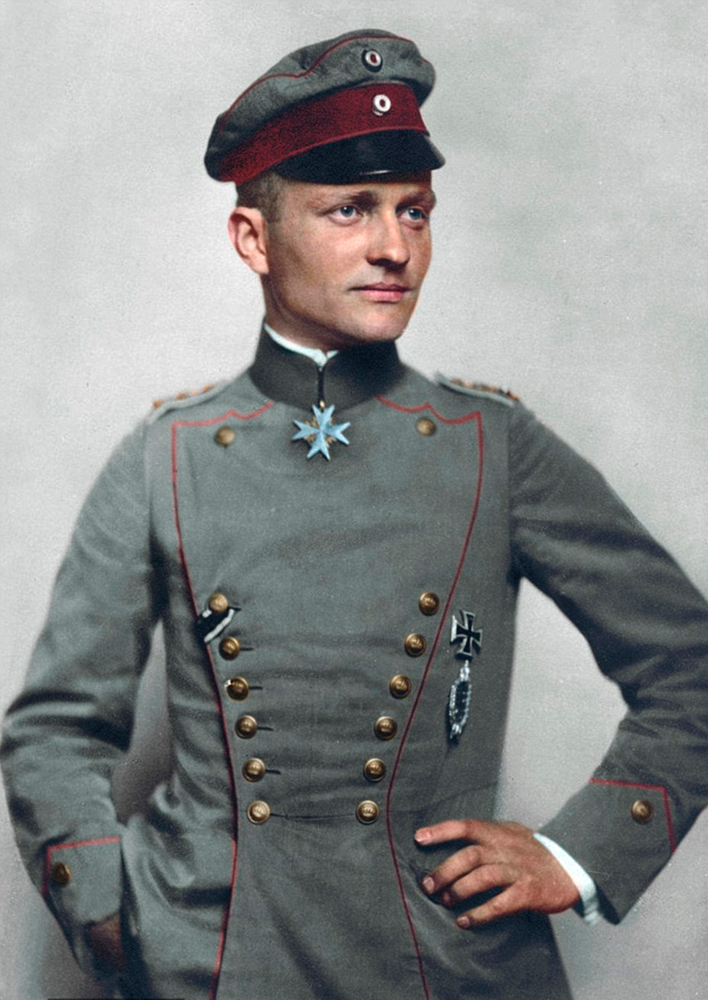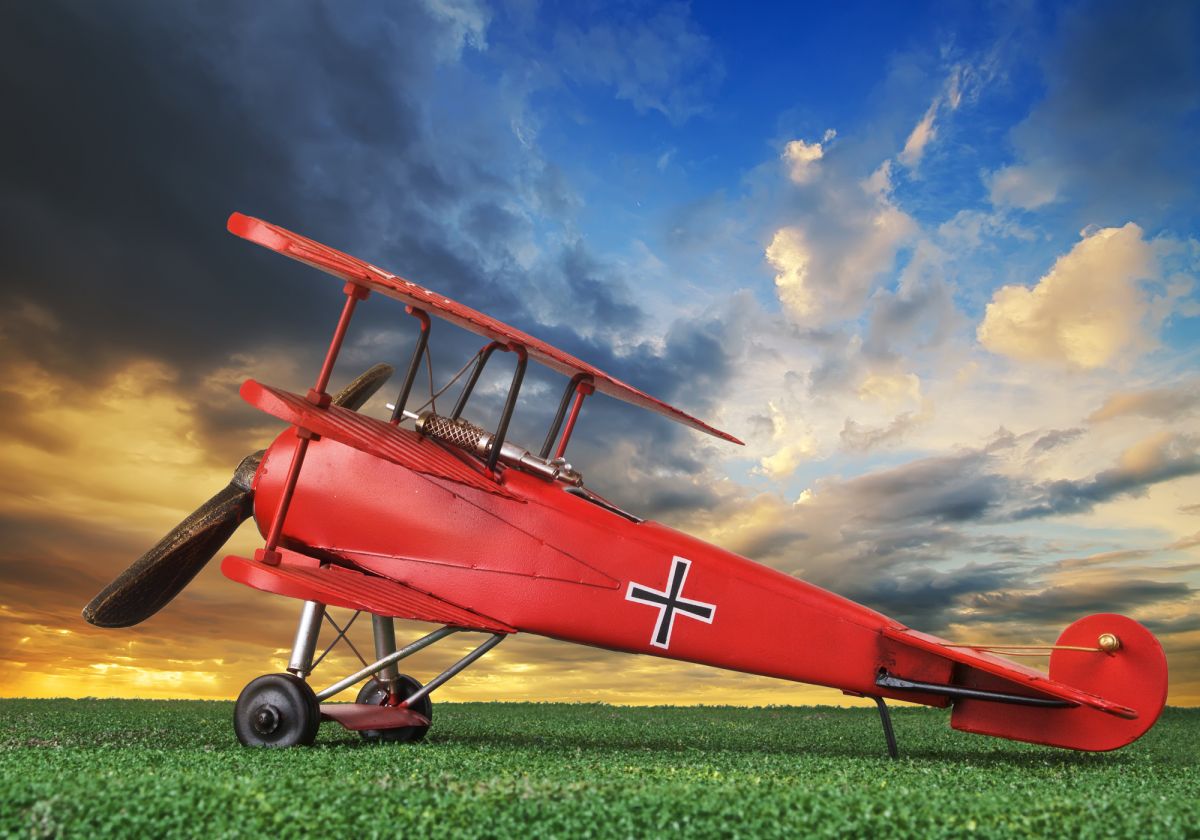- AUST POST SHIPPING
- 0438 654 235
- info@recoverycurios.com
- P.O. Box 7640 Cairns QLD Australia, 4870
-
0
Shopping Cart

Hand-crafted tin/metal retro-style Red Baron Triplane - 40cm wingspan

Pride and place on a lounge side-table, executive desk, cabinet table, hotel or office foyer, or suspended from a bedroom ceiling, this fantastic hand-made retro-style all-metal model of the infamous Red Baron Fokker Triplane is guaranteed to turn heads wherever it's displayed.
A fantastic executive or man-cave gift or an awesome display piece in any teenager’s bedroom, the all metal retro-style Red Baron recreates WWI German air ace, Manfred von Richthofen's personal aircraft.
The Fokker Dr.1 Triplane has undoubtedly become one of the most famous and celebrated iconic fighters of WWI. It’s distinctive cantilevered, triple wing supported by a revolutionary single strut design gave it an incredible manoeuvrability although it suffered from a much slower speed than many of its contemporary opponents whilst diving. Piltos also found its triple wing design severely obstructing their view on take off and landing.
Inspired by the speed and devastating fighting ability of the recently introduced British Sopwith Triplane over the Western Front in early 1917, Anthony Fokker inspected a captured Sopwith whilst visiting one of the forward German Jasta (squadrons). Upon his return to the Schwerin factory he immediately instructed his head designer Reinhold Platz to build a triplane but apparently gave little information about the British design or specifications.
The resulting prototype was a heavy and cumbersome design plagued by significant wing stresses and control issues due largely to its inadequately supported thick cantilevered wings and underpowered engine.
 A revised prototype was developed which introduced horn-balanced ailerons and elevators together with lengthened wings and interplane struts which significantly reduced wing flexing. Together with a more powerful engine, 20 pre -production models were released for front line testing but despite the factory modifications, wing failure issues continued.
A revised prototype was developed which introduced horn-balanced ailerons and elevators together with lengthened wings and interplane struts which significantly reduced wing flexing. Together with a more powerful engine, 20 pre -production models were released for front line testing but despite the factory modifications, wing failure issues continued.
On 29 October 1917, Leutnant der Reserve Heinrich Gontermann, Staffelführer of Jasta 15, was performing aerobatics when his aircraft simply fell apart in the sky. Gontermann was fatally injured in the ensuing crash landing. Another pilot was killed only two days later when his triplane broke up in level flight. Wreckage inspection revealed that the wings had been poorly constructed. Examination of other triplanes confirmed these findings. The triplane was immediately grounded when it was concluded that poor construction and lack of waterproofing had allowed moisture to damage the wing structure causing the wing ribs to disintegrate and the ailerons to break away in flight.
 The Fokker factory immediately improved quality control on the production line, particularly varnishing of the wing spars and ribs to combat moisture. Fokker also strengthened the rib structures and the attachment of the auxiliary spars to the ribs. Existing triplanes were also modified and after testing the modified wing, the triplane was authorised to return to service in late 1917. By January 1918, Jastas 6 and 11 were fully equipped with the triplane but despite their later success, less than 220 aircraft were ever built with wing failures still continuing.
The Fokker factory immediately improved quality control on the production line, particularly varnishing of the wing spars and ribs to combat moisture. Fokker also strengthened the rib structures and the attachment of the auxiliary spars to the ribs. Existing triplanes were also modified and after testing the modified wing, the triplane was authorised to return to service in late 1917. By January 1918, Jastas 6 and 11 were fully equipped with the triplane but despite their later success, less than 220 aircraft were ever built with wing failures still continuing.
 Despite some its its structural issues, the Fokker Dr.1 took on almost iconic respect and recognition when it became the primary aircraft of legendary German flying ace, Manfred von Richthofen who had already notched up 71 victories prior to its arrival at the ‘Red Baron’s’ new command, Jagdgeschwader 1, which was composed of fighter squadrons No. 4, 6, 10, and 11.
Despite some its its structural issues, the Fokker Dr.1 took on almost iconic respect and recognition when it became the primary aircraft of legendary German flying ace, Manfred von Richthofen who had already notched up 71 victories prior to its arrival at the ‘Red Baron’s’ new command, Jagdgeschwader 1, which was composed of fighter squadrons No. 4, 6, 10, and 11.
Renown for the distinctive and flamboyant colour schemes applied to their aircraft along with their use of tents, trains and caravans for increased mobility, the squadron became widely known as "The Flying Circus” and boasted some of the most successful German pilots, many of whom  Richthofen had trained himself, and several of whom later became leaders of their own squadrons. The Baron’s brother Lothar von Richthofen also joined the squadron but was seriously injured after his aircraft suffered a failure of the upper wing leading edge during combat with Sopwith Camels and Bristol F.2Bs of No. 62 Squadron and crashed landed.
Richthofen had trained himself, and several of whom later became leaders of their own squadrons. The Baron’s brother Lothar von Richthofen also joined the squadron but was seriously injured after his aircraft suffered a failure of the upper wing leading edge during combat with Sopwith Camels and Bristol F.2Bs of No. 62 Squadron and crashed landed.
Richthofen flew the celebrated Fokker Dr.I triplane from late July 1917, with the distinctive red three-winged aircraft claiming another 19 kills before he was mortally wounded pursuing a British Sopwith Camel at very low altitude, piloted by novice Canadian pilot Lieutenant Wilfrid May of No. 209 Squadron, Royal Air Force.
May had just fired upon the Red Baron's cousin Lt. Wolfram von Richthofen and upon seeing his cousin being attacked, Richthofen banked and fired on May, causing him to pull away and saving Wolfram's life.
 Richthofen then pursued May across the Somme and was later spotted and briefly attacked by a Camel piloted by May's school friend and flight commander, Canadian Captain Arthur Brown. Brown had to dive so steeply at very high speed to intervene, he barely avoided hitting the ground before he was able to pull up in time. Richthofen turned to avoid this attack, and then resumed his pursuit of May.
Richthofen then pursued May across the Somme and was later spotted and briefly attacked by a Camel piloted by May's school friend and flight commander, Canadian Captain Arthur Brown. Brown had to dive so steeply at very high speed to intervene, he barely avoided hitting the ground before he was able to pull up in time. Richthofen turned to avoid this attack, and then resumed his pursuit of May.
It was during this final stage in his pursuit that a single .303 bullet hit Richthofen, mortally wounding him. In the last seconds of his life, he managed to retain sufficient control to make a rough landing in a field on a hill near the Bray-Corbie road, in a sector controlled by the Australian Imperial Force.
On 22 April 1918, No. 3 Squadron AFC officers became pallbearers and other ranks from the squadron acted as a guard of honour for the funeral of Germany’s greatest flying ace who was buried with full military honours in the cemetery at the village of Bertangles, near Amiens.
Hand-crafted and hand painted, all tin/metal, classic aviation collectable
Length: 35cm
Height: 18cm
Wing span: 40cm
Weight: .8kg
* Please note that because each model is uniquely hand made some variation in sizes might occur
- LAND
- SEA
- AIR
- VINTAGE ORIGINAL AIRCRAFT INSTRUMENTS
- HAWKER TYPHOON
- VICKERS WELLINGTON
- FAIREY GANNET
- RYAN ST-A SPORTS TRAINER
- DE HAVILLAND TIGER MOTH
- JUNKERS JU 87
- HANDLEY PAGE HAMPDEN
- SUPERMARINE SEAFIRE
- B-25 MITCHELL BOMBER
- BRISTOL BLENHEIM
- ENGLISH ELECTRIC LIGHTNING
- HAWKER TEMPEST MkVI
- YAKOVELOV YAK - 3
- FOCKE-WULF FW190
- FOLLAND GNAT
- AIRSPEED OXFORD
- AVRO ANSON
- DOUGLAS C-133 CARGOMASTER
- HANDLEY PAGE VICTOR BOMBER
- DE HAVILLAND SEA VENOM
- VICKERS VALIANT BOMBER
- DOUGLAS A-26 INVADER
- GRUMMAN S2F TRACKER
- SUPERMARINE SPITFIRE
- LOCKHEED P2-V NEPTUNE
- P-51 MUSTANG
- BRISTOL BEAUFIGHTER
- DE HAVILLAND MOSQUITO
- B-26 MARTIN MARAUDER
- P3 ORION
- DOUGLAS A-20 HAVOC
- P-39 AIRACOBRA
- AVRO SHACKLETON
- B-17 FLYING FORTRESS
- B-24 LIBERATOR
- MESSERSCHMITT BF-110
- MESSERSCHMITT BF-109
- BRISTOL BEAUFORT
- KAWASAKI Ki-45 (NICK) INTERCEPTOR
- C-130 HERCULES
- CAC BOOMERANG
- AVRO LANCASTER
- GRUMMAN F4F WILDCAT
- F4U VOUGHT CORSAIR
- WESTLAND LYSANDER
- P-47 REPUBLIC THUNDERBOLT
- NORTH AMERICAN T-6 TEXAN - HAVARD
- C-47 SKYTRAIN
- DOUGLAS SBD DAUNTLESS
- CAC WIRRAWAY
- PBY CATALINA
- P-40 WARHAWK
- FAIREY SWORDFISH
- P-38 LIGHTNING
- HAWKER HURRICANE
- CURTISS SB2C HELLDIVER
- GRUMMAN F6F HELLCAT
- SEAKING HELICOPTER
- SEAHAWK HELICOPTER
- DOUGLAS A4G SKYHAWK
- GRUMMAN TBF AVENGER
- HANDLEY PAGE HALIFAX
- DOUGLAS SKYRAIDER AE-1
- GLOSTER METEOR
- JUNKERS JU-88
- F-86 SABRE JET
- SHORT SUNDERLAND
- B-29 SUPER FORTRESS
- F-9F GRUMMAN PANTHER
- F-100D SUPER SABRE
- BELL UH-1 HUEY HELICOPTER
- AVRO VULCAN STRATEGIC BOMBER
- CANBERRA BOMBER
- DHC-4 CARIBOU
- BLACKBURN BUCCANEER
- DE HAVILLAND VAMPIRE JET
- HAWKER SEA FURY
- LOCKHEED HUDSON
- LOCKHEED EC-121 WARNING STAR
- SEPECAT JAGUAR
- HAWKER SIDDELEY NIMROD
- HAWKER SIDDELEY HARRIER
- ARADO AR 196
- VOUGHT OS2U KINGFISHER
- LOCKHEED ELECTRA
- NORTHROP P-61 BLACK WIDOW
- BOEING CH-47 CHINOOK
- LOCKHEED PV-1 VENTURA
- BOEING P26-A 'PEASHOOTER'
- Ilyushin Il-2 ‘Sturmovik’
- WESTLAND WESSEX
- FAIREY FIREFLY
- VINTAGE AVIATION COLLECTABLES
- VINTAGE COLLECTABLE MODEL AIRCRAFT KITS
- RETRO STYLE METAL AIRCRAFT COLLECTABLES
- VINTAGE ORIGINAL AIRCRAFT INSTRUMENTS




